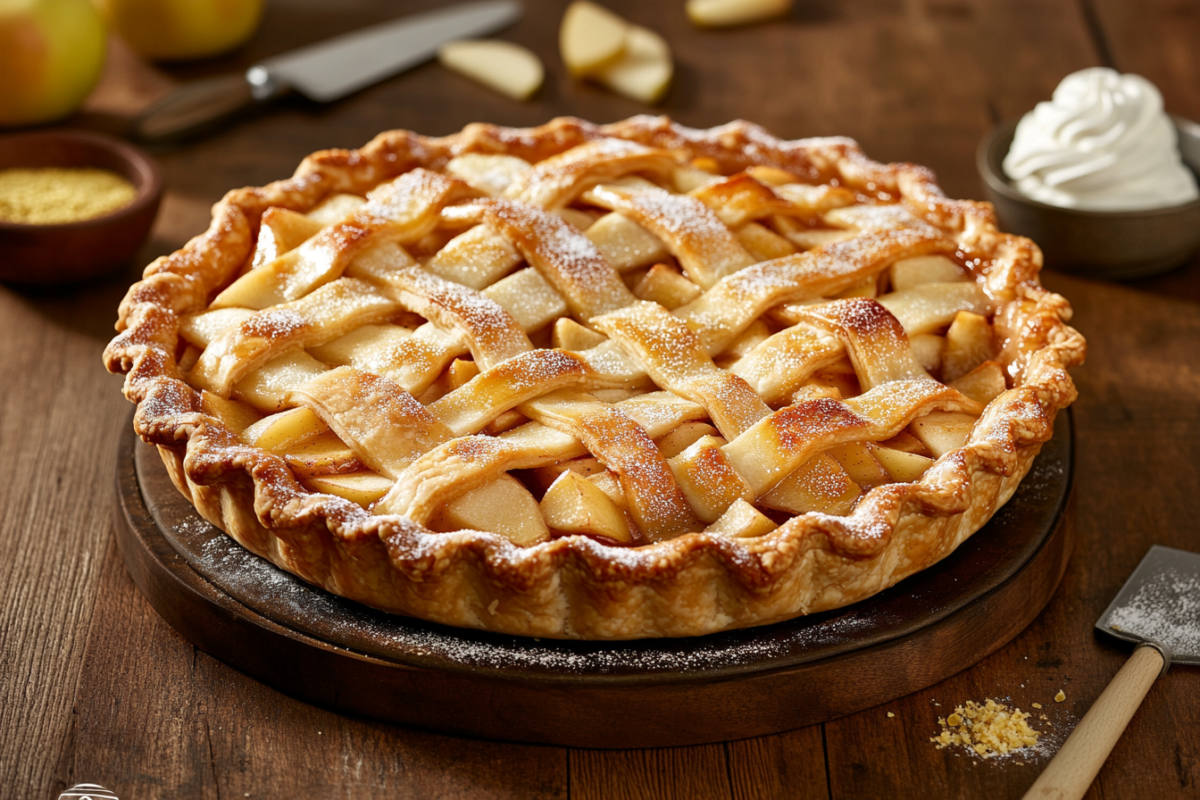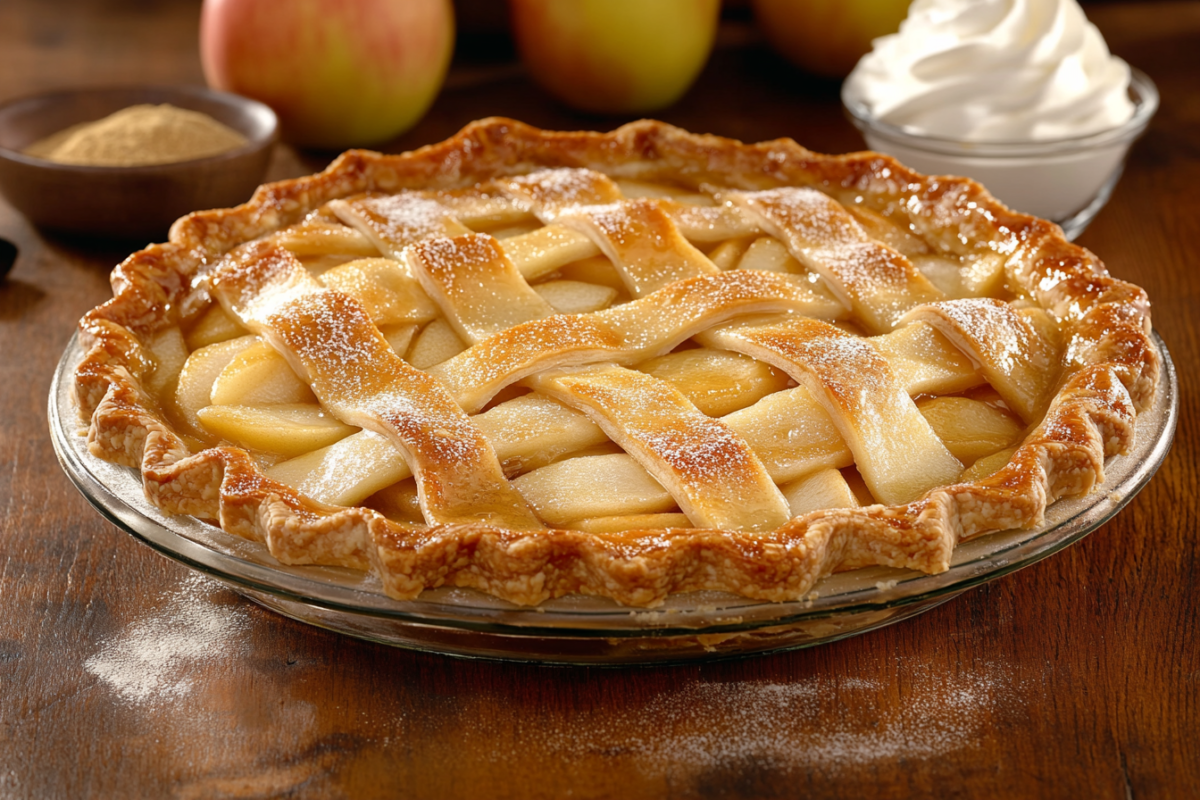Apple pie is a timeless classic, adored by many for its comforting and rich flavors. But what if you could enjoy this dessert without the ever-so-common ingredient, cinnamon? Apple pie without cinnamon offers a refreshing twist, opening up possibilities for unique flavor combinations that cater to dietary restrictions, allergies, or simply a different taste preference. This guide will take you through its history, ingredients, recipes, and tips for crafting the perfect pie.
What Is an Apple Pie Without Cinnamon?
Apple pie without cinnamon isn’t just a novelty; it’s a creative reimagining of a traditional dessert. By leaving out cinnamon, this recipe focuses on other delicious flavors that can shine just as brightly. The idea isn’t new—throughout history, variations of apple pies have existed without cinnamon, relying on the natural sweetness and tartness of apples or alternative spices for their unique tastes.
Why Skip Cinnamon?
Skipping cinnamon doesn’t mean compromising flavor. Instead, it opens doors to alternative spices like nutmeg, ginger, or cardamom. For some, avoiding cinnamon is a necessity due to allergies or sensitivities. For others, it’s a choice to explore different profiles that highlight apples’ natural essence.
The Appeal of a Cinnamon-Free Apple Pie
This version of apple pie is versatile. You can use a medley of tart and sweet apples, incorporate a hint of vanilla or lemon zest, and achieve a refreshing dessert that feels lighter yet just as comforting. It’s perfect for those who crave tradition but aren’t afraid to veer off the beaten path.
History and Tradition of Apple Pie
Origins of Apple Pie
The story of apple pie is as rich as its buttery crust. While apple pie is often thought of as quintessentially American, its origins trace back to Europe. The first recorded recipes date to 14th-century England, where cooks combined apples with figs, raisins, and pears. Interestingly, early apple pies didn’t include sugar, as it was a luxury item, and the crust, called a “coffin,” wasn’t meant to be eaten—it served as a container for the filling.
As the recipe traveled across borders, it evolved. By the 17th century, Dutch and French influences brought new techniques and flavors, including the flakey pastry crust we know today. When settlers brought apple seeds to North America, the fruit flourished, leading to the now-iconic apple pie recipe.
Traditional Ingredients and Spices
Classic apple pie recipes often include apples, sugar, butter, and a mix of spices to enhance the filling’s flavor. Cinnamon became a staple, not just for its warm, sweet-spicy profile but also for its availability during colonial times. Nutmeg and cloves sometimes accompanied cinnamon to create a complex, aromatic spice blend.
However, the beauty of apple pie lies in its adaptability. Even without cinnamon, pies can shine with alternative spices like ginger, cardamom, or even a hint of lemon zest for brightness. The crust, made with flour, butter, and sometimes a touch of sugar, is another essential element, providing the perfect contrast to the soft, spiced apple filling.
Reasons to Make Apple Pie Without Cinnamon
Dietary Restrictions and Allergies
Cinnamon is a popular spice, but for some, it can be problematic. Allergies and sensitivities to cinnamon, though not overly common, are real and can cause unpleasant reactions such as skin irritation, stomach upset, or even difficulty breathing. For individuals with these conditions, creating an apple pie without cinnamon is not just a preference—it’s a necessity.
Moreover, certain dietary practices, such as elimination diets or preferences for milder spices, may exclude cinnamon altogether. By focusing on alternatives, you can create a dessert that caters to everyone’s needs without sacrificing flavor or enjoyment.
Flavor Preferences
Let’s face it: not everyone loves cinnamon. Its bold, spicy-sweet taste can sometimes overpower the delicate sweetness of apples. For those who prefer a more subtle or unique flavor profile, skipping cinnamon allows other ingredients to take center stage.
Alternative spices such as nutmeg, cardamom, or even ginger offer distinctive tastes that can elevate your pie without overshadowing the natural flavor of the apples. For instance:
- Nutmeg adds warmth and depth, similar to cinnamon but milder.
- Cardamom brings a floral, slightly citrusy aroma, making the pie feel fresh and exotic.
- Ginger delivers a gentle heat that complements apples beautifully.
- Vanilla extract or beans can enhance sweetness and create a creamy undertone.
- Lemon zest provides a bright and tangy twist that balances the richness of the filling.
These alternatives allow for endless customization. Want a lighter, fresher pie? Add lemon zest and a hint of vanilla. Craving a spicier kick? Incorporate ginger or cardamom. The possibilities are as varied as the preferences of those enjoying the pie.
By making an apple pie without cinnamon, you’re not just accommodating dietary needs; you’re unlocking a world of flavor combinations that might even convert the staunchest cinnamon lovers. Whether for health reasons or taste preferences, this variation of a classic dessert proves that cinnamon isn’t the only spice in the pantry capable of creating a masterpiece.
Alternative Spices and Flavorings

One of the joys of skipping cinnamon in apple pie is discovering the wide variety of spices and flavorings that can create an equally, if not more, delightful dessert. Each alternative brings its own character, allowing for endless creative combinations. Let’s explore some of the best substitutes.
Nutmeg
Nutmeg is a classic spice that pairs beautifully with apples. Its warm, nutty flavor adds depth to the filling without overpowering it. When using nutmeg as a substitute for cinnamon, less is more—too much can make the pie taste overly spicy.
How to Use:
- Add 1/4 to 1/2 teaspoon of freshly grated nutmeg to your apple pie filling.
- Combine with a pinch of salt to bring out the natural sweetness of the apples.
Nutmeg shines when paired with other spices like vanilla or ginger, creating a well-rounded flavor profile.
Ginger
If you want to add a bit of zing to your pie, ginger is an excellent choice. Its slightly spicy and peppery notes complement the sweetness of apples, creating a filling that’s both comforting and lively.
How to Use:
- Use 1/4 to 1/2 teaspoon of ground ginger in your filling for a gentle heat.
- For a fresher taste, grate a small amount of fresh ginger into the mixture.
Ginger works especially well with tart apple varieties like Granny Smith or Honeycrisp, enhancing their natural tanginess.
Cardamom
Cardamom is a spice often overlooked in baking, but it can transform an apple pie into something truly unique. Its floral and citrusy aroma adds a touch of elegance to the filling.
How to Use:
- Use 1/4 teaspoon of ground cardamom for a light, exotic flavor.
- Pair it with a splash of vanilla extract to balance its intensity.
Cardamom’s versatility makes it a great option for those looking to create a pie that stands out.
Vanilla
Vanilla is a beloved ingredient for a reason—it enhances the natural sweetness of apples and adds a creamy, comforting undertone to the pie. Whether using vanilla extract, paste, or whole beans, this flavoring is a foolproof way to elevate your dessert.
How to Use:
- Add 1 teaspoon of vanilla extract to the apple mixture before baking.
- For a richer taste, scrape the seeds from a vanilla bean and mix them into the filling.
Vanilla pairs wonderfully with spices like nutmeg or ginger, adding depth without competing for attention.
Lemon Zest
For a burst of freshness, lemon zest is a fantastic addition to apple pie. Its bright, tangy notes cut through the richness of the filling, creating a more balanced flavor profile.
How to Use:
- Grate the zest of one lemon into the filling mixture before baking.
- Pair with a pinch of nutmeg or cardamom for a lively twist.
Selecting the Right Apples
The key to a delicious apple pie without cinnamon starts with choosing the right apples. The variety you select plays a crucial role in the texture, sweetness, and overall flavor of your pie. A mix of apples often works best to strike a balance between tartness and sweetness, ensuring every bite is flavorful and satisfying.
Best Apple Varieties for Pie
- Honeycrisp: These apples offer a perfect balance of sweetness and crispness, creating a juicy filling that doesn’t turn mushy.
- Braeburn: With their tangy-sweet flavor and firm texture, Braeburn apples are excellent for baking.
- Golden Delicious: Sweet and mild, these apples add a natural sweetness to your pie and blend well with tart varieties.
- Pink Lady: Slightly tart with a hint of sweetness, Pink Lady apples bring a unique depth of flavor to the pie.
Using a mix of these varieties can create a more complex and balanced flavor.
Balancing Sweetness and Tartness
Achieving the right balance of sweetness and tartness is key to a well-rounded apple pie. Too sweet, and the pie becomes cloying; too tart, and it might lack the comforting warmth of a dessert.
Tips for Balancing Flavors:
- Combine tart apples like Granny Smith with sweeter varieties like Honeycrisp or Golden Delicious.
- Taste the apples beforehand to gauge their natural flavor profile.
- Adjust the sugar in your recipe based on the sweetness of the apples
Serving Suggestions for Apple Pie Without Cinnamon
Pairing Apple Pie Without Cinnamon with Ice Cream or Whipped Cream
No slice of apple pie without cinnamon is complete without the perfect topping! A scoop of vanilla ice cream is the classic choice, offering a creamy contrast to the flaky crust and spiced apple filling.
For a lighter option, freshly whipped cream, with a touch of sugar and vanilla extract, adds a simple yet luxurious element that complements the pie perfectly.
Best Beverages to Pair with Cinnamon-Free Apple Pie
Pairing your cinnamon-free apple pie with the right beverage enhances the dessert experience. Some excellent options include:
- Hot beverages: Black tea, herbal tea with ginger, or black coffee balance the sweetness.
- Cold beverages: Sparkling apple cider or chilled milk for a refreshing contrast.
- Non-alcoholic options: Warm spiced apple cider (without cinnamon) infused with nutmeg or cloves for a festive touch.
These accompaniments ensure your apple pie without cinnamon is a delightful treat at any occasion.
Frequently Asked Questions About Apple Pie Without Cinnamon
Can I Make Apple Pie Without Cinnamon or Any Spices?
Yes, it’s entirely possible to create apple pie without cinnamon or any spices. Highlight the natural flavors of apples with additions like lemon juice or vanilla extract for a fresh and clean taste.
What Fruits Work Best with Cinnamon-Free Apple Pie?
Adding other fruits to cinnamon-free apple pie opens up new flavor possibilities. Consider these combinations:
- Pears for a mild, juicy pairing.
- Cranberries for tartness and color.
- Raspberries for a sweet-tangy twist.
- Peaches or apricots for summery sweetness.
These fruits blend seamlessly with apples to create exciting variations of apple pie without cinnamon.
How Do I Store Leftovers of Apple Pie Without Cinnamon?
To keep your apple pie without cinnamon fresh:
- Room temperature: Cover and store for up to two days.
- Refrigerator: Wrap in plastic or foil and refrigerate for up to five days.
- Freezer: Wrap slices in plastic wrap and foil, then freeze for up to three months.
Reheat leftovers in a 350°F (175°C) oven for the best results.
Can I Use Pre-Made Crust for Apple Pie Without Cinnamon?
Yes, store-bought crust works well for apple pie without cinnamon and saves time. Enhance its flavor by brushing it with melted butter and sprinkling sugar before baking.
How Can I Make Apple Pie Without Cinnamon Healthier?
To make apple pie without cinnamon healthier:
- Use naturally sweet apples to reduce added sugar.
- Replace sugar with honey or maple syrup for natural sweetness.
- Opt for a whole wheat crust or reduce the butter in the recipe.
- Add oats to the filling for extra fiber and texture.

